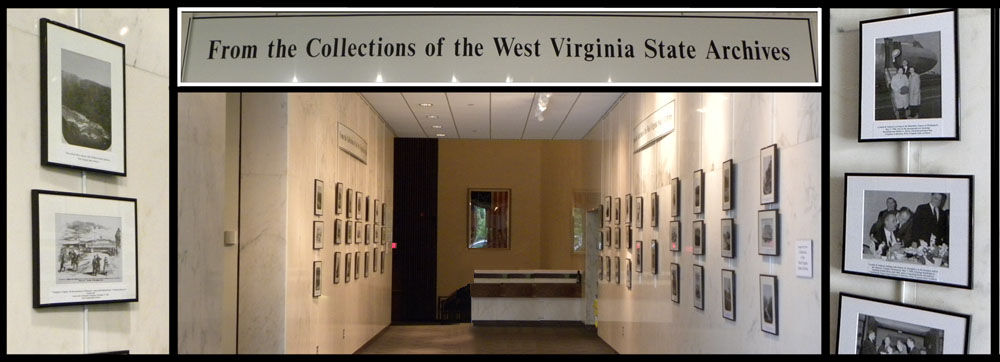The John Brown exhibit was on display in the Archives and History Photo Gallery between September and December 2009 in connection with the premiere of Archives and History's permanent online exhibit "'His Soul Goes Marching On': The Life and Legacy of John Brown."
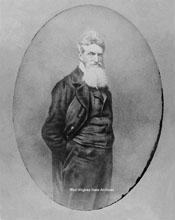 | Photograph, John Brown wearing the full beard with which he is most often associated. This image is based on a photograph taken in May 1859 and attributed to James W. Black of Boston. Boyd B. Stutler Collection, West Virginia State Archives
|
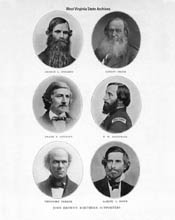 | Photograph, George L. Stearns, Gerrit Smith, Frank B. Sanborn, T. W. Higginson, Theodore Parker, and Samuel G. Howe, the six northern supporters of John Brown's activities. Boyd B. Stutler Collection, West Virginia State Archives
|
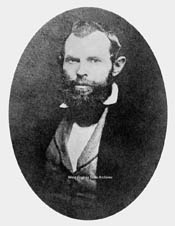 | Photograph, Owen Brown, son of John Brown, escaped after the raid on Harpers Ferry and was the last survivor among the raiders. He died in California in 1889. Boyd B. Stutler Collection, West Virginia State Archives |
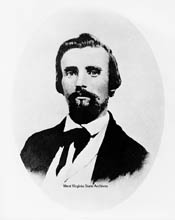 | Photograph, Watson Brown, son of John Brown, was mortally wounded during the raid on Harpers Ferry and died on October 19, 1859. His corpse was taken to the Winchester Medical College, where it was skinned and used as an anatomical specimen. Boyd B. Stutler Collection, West Virginia State Archives
|
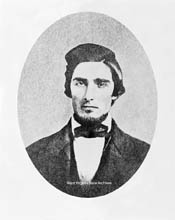 | Photograph, Jeremiah Goldsmith Anderson served with John Brown in Kansas before participating in the raid on Harpers Ferry. Anderson was bayoneted when U.S. Marines assaulted the fire engine house and died on October 18, 1859. His body was taken to the Winchester Medical College. Boyd B. Stutler Collection, West Virginia State Archives
|
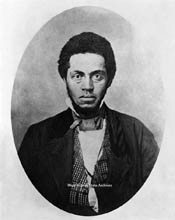 | Photograph, Osborn Perry Anderson was a free black living in Canada when he met John Brown at the Chatham Convention in 1858. He was the only one of the African American raiders to escape. Anderson wrote about his experiences in A Voice from Harpers Ferry, printed in 1861. Boyd B. Stutler Collection, West Virginia State Archives |
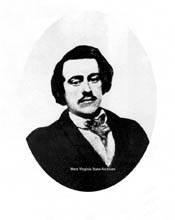 | Photograph, John E. Cook joined John Brown in Kansas and came to Harpers Ferry in advance of the raid, where he married a local girl. Captured a week after the raid, he confessed to his role in the raid and was hanged on December 16, 1859. Boyd B. Stutler Collection, West Virginia State Archives |
 | Photograph, John Anthony Copeland, a free black, was a recent recruit to John Brown's group, arriving at the Kennedy Farm only in October 1859. He was captured during the raid and hanged alongside Shields Green on December 16, 1859. His body and that of Green were sent to the Winchester Medical College for dissection. Boyd B. Stutler Collection, West Virginia State Archives
|
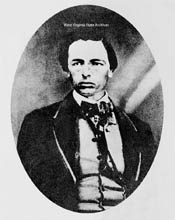 | Photograph, Barclay Coppic was recruited by John Brown in Iowa along with his brother Edwin. Edwin was captured during the raid on Harpers Ferry, but Barclay escaped. He died in a troop train accident in Kansas during the Civil War in 1861. Boyd B. Stutler Collection, West Virginia State Archives
|
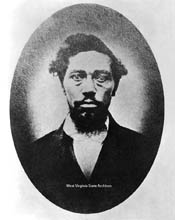 | Photograph, Dangerfield Newby, a freedman, joined John Brown in hopes of rescuing his wife and children from slavery in Virginia. He was killed during the raid on October 17, 1859. Boyd B. Stutler Collection, West Virginia State Archives
|
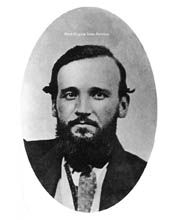 | Photograph, Aaron Dwight Stevens, John Brown's third in command at Harpers Ferry, was the only raider with prior military service. He was in the army during the Mexican War and enlisted again in 1851, serving until he was court-martialed in 1855. Escaping, he joined the Free State cause in Kansas under the alias of Charles Whipple. Stevens was wounded and captured during the raid and was hanged March 16, 1860. Boyd B. Stutler Collection, West Virginia State Archives
|
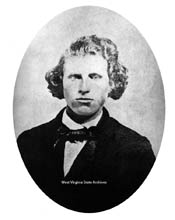 | Photograph, Dauphin Thompson was a brother-in-law of John Brown's daughter Ruth. He was killed during the assault on the fire engine house on October 18, 1859. Boyd B. Stutler Collection, West Virginia State Archives
|
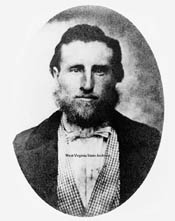 | Photograph, William Thompson, older brother of Dauphin, was captured early in the Harpers Ferry raid but was later taken to the bridge by an angry group of citizens and shot several times. Boyd B. Stutler Collection, West Virginia State Archives |
 | Photograph, The Kennedy Farm in Maryland, where John Brown and his men stayed before their raid on Harpers Ferry. In this 1930 photograph, African American guide Lawrence Washington is standing beside the porch. Boyd B. Stutler Collection, West Virginia State Archives
|
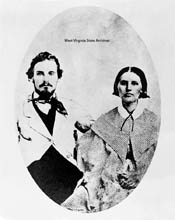 | Photograph, Oliver and Martha Brown, John Brown's youngest son and daughter-in-law. Oliver was killed in the raid on Harpers Ferry, while Martha, who was at the Kennedy Farm for several weeks before the raid, died in 1860. Boyd B. Stutler Collection, West Virginia State Archives
|
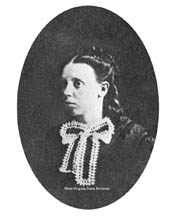 | Photograph, Annie Brown, daughter of John Brown, stayed at the Kennedy Farm for several weeks before the raid to help allay possible suspicions among neighbors about the residents of the farm. Boyd B. Stutler Collection, West Virginia State Archives
|
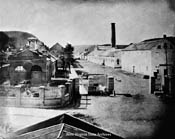 | Photograph, This pre-war view of the federal musket factory complex at Harpers Ferry shows the fire engine house that would become famous as John Brown's Fort at left. Boyd B. Stutler Collection, West Virginia State Archives
|
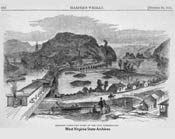 | Photograph, "Harper's Ferry:The Scene of the Late Insurrection." This view shows the town from the Maryland side of the Potomac River. Harper's Weekly, October 29, 1859. Boyd B. Stutler Collection, West Virginia State Archives
|
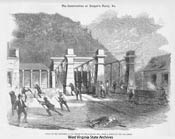 | Photograph, "Attack on the Insurgents at the Bridge by the Railroad Men." Frank Leslie's Illustrated Newspaper, October 29, 1859, West Virginia State Archives
|
 | Photograph, Lewis W. Washington, a Jefferson County resident and the great grandnephew of President George Washington, was held hostage by John Brown during the Harpers Ferry raid. Boyd B. Stutler Collection, West Virginia State Archives
|
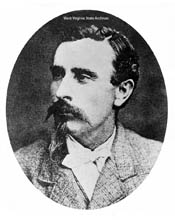 | Photograph, John Thomas Allstadt, son of Jefferson County farmer John Allstadt. Both father and son, then a teenager, were taken prisoner during John Brown's raid on Harpers Ferry. Boyd B. Stutler Collection, West Virginia State Archives |
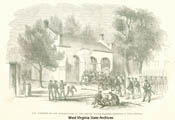 | Photograph, "The Storming of the Engine-House, by the United States Marines." This sketch by Porte Crayon (David Hunter Strother) shows the marines entering the engine house on October 18 after battering in the door with a ladder. Harper's Weekly, November 5, 1859, West Virginia State Archives |
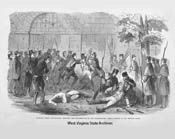 | Photograph, "Harper's Ferry Insurrection:Bringing the Prisoners Out of the Engine-House." A wounded John Brown and his dead son Oliver are shown laying on the ground. Frank Leslie's Illustrated Newspaper, November 5, 1859, West Virginia State Archives |
 | Photograph, "Brown, His Son, and Another of the Outlaws Awaiting Examination." Sketch by Porte Crayon. Harper's Weekly, November 5, 1859, West Virginia State Archives |
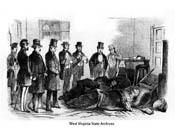 | Photograph, "Governor Wise, of Virginia, and District Attorney Ould Examining the Wounded Prisoners in the Presence of the Officers, the Reporter of the N. Y. Herald and Our Special Artist." Frank Leslie's Illustrated Newspaper, October 29, 1859. Boyd B. Stutler Collection, West Virginia State Archives
|
 | Photograph, "Harper's Ferry Insurrection:Burying the Dead Insurgents." Frank Leslie's Illustrated Newspaper, November 5, 1859, West Virginia State Archives
|
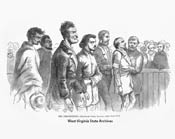 | Photograph, "The Arraignment." John Brown, John Copeland, Edwin Coppic, Shields Green, and Aaron Stevens are shown being arraigned in the Jefferson County courthouse in Charles Town on October 25. Sketch by Porte Crayon. Harper's Weekly, November 12, 1859, West Virginia State Archives |
 | Photograph, "John Brown's Trial at Charlestown, Virginia," by David C. Lithgow, 1923. This painting hangs in the Essex County, New York, courthouse, where John Brown's body lay on December 6, 1859, on its way for burial at North Elba. Boyd B. Stutler Collection, West Virginia State Archives |
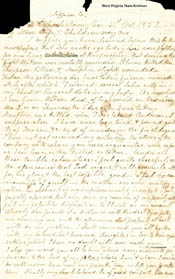 | Document, In this October 31, 1859, letter to his family, John Brown writes about the raid and his conviction of treason and murder. He advises them of his sentence to hang in a postscript dated November 2. Boyd B. Stutler Collection, West Virginia State Archives |
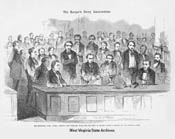 | Photograph, "The Prisoners Cook, Coppic, Greene and Copeland Receiving Sentence of Death." Frank Leslie's artist sketched this scene as John Cook, Edwin Coppic, Shields Green, and John Copeland heard Judge Richard Parker sentence them to hang on December 16. Frank Leslie's Illustrated Newspaper, November 26, 1859, West Virginia State Archives |
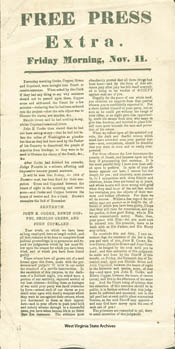 | Document, November 11, 1859, extra published by the Virginia Free Press of Charles Town, issuing the death sentence to John E. Cook, John A. Copeland, Edwin Coppic, and Shields Green. Collector Boyd Stutler knew of no other existing copy of this piece. Boyd B. Stutler Collection, West Virginia State Archives |
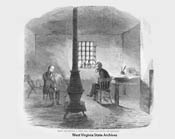 | Photograph, "Brown and Stevens in Their Cell, Three Days before the Execution." New York Illustrated News, December 10, 1859, West Virginia State Archives |
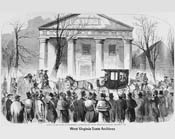 | Photograph, "Arrival of Mrs. Brown in Charlestown, Accompanied by Capt. Moore, and an Escort, December 1, 1859." New York Illustrated News, December 17, 1859. Boyd B. Stutler Collection, West Virginia State Archives |
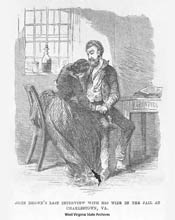 | Photograph, "John Brown's Last Interview with His Wife in the Jail at Charlestown, Va." Mary Ann Brown had wanted to see her husband earlier, but John Brown had requested she not come. Only shortly before his execution did he write that she could come. Frank Leslie's Illustrated Newspaper, December 17, 1859, West Virginia State Archives
|
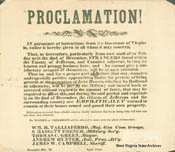 | Document, Fearing attempts to rescue John Brown, Virginia authorities issued this proclamation before his execution warning strangers against coming to Jefferson County and telling citizens to remain at home. Boyd B. Stutler Collection, West Virginia State Archives
|
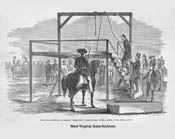 | Photograph, "John Brown Ascending the Scaffold Preparatory to Being Hanged." Brown was executed in a field outside Charles Town on December 2, 1859. Frank Leslie's Illustrated Newspaper, December 17, 1859, West Virginia State Archives
|
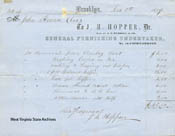 | Document, Receipted bill from undertaker J. M. Hopper of Brooklyn for preparing the body of John Brown. Because the trip from Charles Town to North Elba took several days, Brown's body needed undertaking services en route to preserve it. Boyd B. Stutler Collection, West Virginia State Archives
|
 | Photograph, "The Burial of John Brown, at North Elba, Dec. 8, from a Sketch by Our Own Artist." New York Illustrated News, December 24, 1859. Boyd B. Stutler Collection, West Virginia State Archives |
 | Photograph, This 1880s view of John Brown's Fort shows the fire engine house on its original site at the old armory grounds. Note the lettering above the doors. Photo by W. C. Russell. Boyd B. Stutler Collection, West Virginia State Archives
|
 | Document, "John Brown Souvenir" available at the World's Columbian Exposition in Chicago in 1893. The front (shown here) presents John Brown's last words. On the reverse is an illustration and biographical sketch of Brown. Boyd B. Stutler Collection, West Virginia State Archives
|

